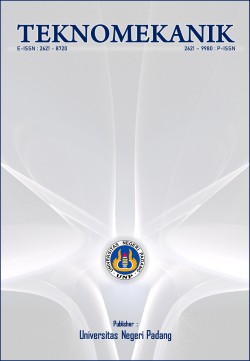Enhancing biodegradable polymer surface wettability properties through atmospheric plasma treatment and nanocellulose incorporation
DOI:
https://doi.org/10.24036/jptk.v7i2.36723Keywords:
Biodegradable Polymers, Polylactic Acid (PLA), Nanocrystalline Cellulose (CNC), Atmospheric Plasma Treatment, Surface WettabilityAbstract
This study investigates the effects of atmospheric plasma treatment on the surface properties of polylactic acid (PLA)/nanocrystalline cellulose (CNC) composites, aiming to improve their wettability and mechanical properties. The research utilizes a twin-screw extrusion process for fabricating PLA/CNC biocomposites, followed by surface modification using a custom-built, with a tenfold high-voltage atmospheric plasma system. The motivation of this treatment was to improved surface wettability and potential for enhanced adhesive bonding in ecological applications. These findings contribute to developing more sustainable composite materials by providing a method to improve the functionality of biodegradable polymers without compromising their environmental benefits.
Downloads
References
Agrawal, C. M., & Ray, R. B. (2001). Biodegradable polymeric scaffolds for musculoskeletal tissue engineering. Journal of Biomedical Materials Research, 55(2). https://doi.org/10.1002/1097-4636(200105)55:2<141::AID-JBM1000>3.0.CO;2-J
Akbar, I. M., Fauza, A. N., Abadi, Z., & Rahmadiawan, D. (2024). Study of the effective fraction of areca nut husk fibre composites based on mechanical properties. Journal of Engineering Researcher and Lecturer, 3(1), 19–34. https://doi.org/10.58712/jerel.v3i1.126
Chou, C.-T., Shi, S.-C., & Chen, C.-K. (2021). Sandwich-Structured, Hydrophobic, Nanocellulose-Reinforced Polyvinyl Alcohol as an Alternative Straw Material. Polymers, 13(24), 4447. https://doi.org/10.3390/polym13244447
Chou, C.-T., Shi, S.-C., Chen, T.-H., & Chen, C.-K. (2023). Nanocellulose-reinforced, multilayered poly(vinyl alcohol)-based hydrophobic composites as an alternative sealing film. Science Progress, 106(1), 003685042311571. https://doi.org/10.1177/00368504231157142
Jordá-Vilaplana, A., Sánchez-Nácher, L., Fombuena, V., García-García, D., & Carbonell-Verdú, A. (2015). Improvement of mechanical properties of polylactic acid adhesion joints with bio-based adhesives by using air atmospheric plasma treatment. Journal of Applied Polymer Science, 132(32). https://doi.org/10.1002/app.42391
Koizhanova, A., Magomedov, D., Abdyldayev, N., Yerdenova, M., & Bakrayeva, A. (2023). The effect of biochemical oxidation on the hydrometallurgical production of copper. Teknomekanik, 6(1), 12–20. https://doi.org/10.24036/teknomekanik.v6i1.16072
Makruf, Z. I., Afnison, W., & Rahim, B. (2024). A Study on the utilization of areca nut husk fiber as a natural fibre reinforcement in composite applications: A systematic literature review. Journal of Engineering Researcher and Lecturer, 3(1), 18–28. https://doi.org/10.58712/jerel.v3i1.123
Nurdin, H., Waskito, W., Fauza, A. N., Siregar, B. M., & Kenzhaliyev, B. K. (2023). The investigation of physical dan mechanical properties of Nipah-based particle board. Teknomekanik, 6(2), 94–102. https://doi.org/10.24036/teknomekanik.v6i2.25972
Oktaviani, A., Zulfia, A., & Rahmadiawan, D. (2023). Enhancing laminate composites: Investigating the impact of kevlar layering and titanium carbide nanoparticles. Teknomekanik, 6(2), 82–93. https://doi.org/10.24036/teknomekanik.v6i2.26572
Plastics in the Ocean - Ocean Conservancy. (n.d.). Retrieved May 26, 2024, from https://oceanconservancy.org/trash-free-seas/plastics-in-the-ocean/
Prolongo, S. G., Gude, M. R., Del Rosario, G., & Ureña, A. (2010). Surface pretreatments for composite joints: Study of surface profile by SEM image analysis. Journal of Adhesion Science and Technology, 24(11–12). https://doi.org/10.1163/016942410X507623
Rahmadiawan, D., Abral, H., Ilham, M. K., Puspitasari, P., Nabawi, R. A., Shi, S.-C., Sugiarti, E., Muslimin, A. N., Chandra, D., Ilyas, R. A., & Zainul, R. (2023). Enhanced UV blocking, tensile and thermal properties of bendable TEMPO-oxidized bacterial cellulose powder-based films immersed in PVA/Uncaria gambir/ZnO solution. Journal of Materials Research and Technology, 26, 5566–5575. https://doi.org/10.1016/j.jmrt.2023.08.267
Rahmadiawan, D., Abral, H., Shi, S.-C., Huang, T.-T., Zainul, R., Ambiyar, A., & Nurdin, H. (2023). Tribological Properties of Polyvinyl Alcohol/Uncaria Gambir Extract Composite as Potential Green Protective Film. Tribology in Industry, 45(1), 367–274. https://doi.org/10.24874/TI.1482.05.23.06
Rahmadiawan, D., & Shi, S.-C. (2024). Enhanced Stability, Superior Anti-Corrosive, and Tribological Performance of Al2O3 Water-based Nanofluid Lubricants with Tannic Acid and Carboxymethyl Cellulose over SDBS as Surfactant. Scientific Reports, 14(1), 9217. https://doi.org/10.1038/s41598-024-59010-w
Rahmadiawan, D., Shi, S.-C., Abral, H., Ilham, M. K., Sugiarti, E., Muslimin, A. N., Ilyas, R. A., Lapisa, R., & Putra, N. S. D. (2024). Comparative Analysis of the Influence of Different Preparation Methods on the Properties of TEMPO-Oxidized Bacterial Cellulose Powder Films. Journal of Natural Fibers, 21(1). https://doi.org/10.1080/15440478.2023.2301386
Shi, S.-C., & Chang, Y.-W. (2022). Biofriendly chitosan-based high-efficiency dialysis membrane. Progress in Organic Coatings, 170, 106981. https://doi.org/10.1016/j.porgcoat.2022.106981
Shi, S.-C., Chen, T.-H., & Mandal, P. K. (2020). Enhancing the Mechanical and Tribological Properties of Cellulose Nanocomposites with Aluminum Nanoadditives. Polymers, 12(6), 1246. https://doi.org/10.3390/polym12061246
Shi, S.-C., & Chen, X.-A. (2023). Cellulose circular economy: Amino-functionalized graphene quantum dots as highly sensitive vaccine indicators. Industrial Crops and Products, 206, 117694. https://doi.org/10.1016/j.indcrop.2023.117694
Shi, S.-C., & Huang, T.-F. (2018). Effects of temperature and humidity on self-healing behaviour of biopolymer hydroxylpropyl methylcellulose for ecotribology. Surface and Coatings Technology, 350, 997–1002. https://doi.org/10.1016/j.surfcoat.2018.03.039
Shi, S.-C., Lu, F.-I., Wang, C.-Y., Chen, Y.-T., Tee, K.-W., Lin, R.-C., Tsai, H.-L., & Rahmadiawan, D. (2024). Rice straw-derived chitosan-enhanced plasticizers as biologically and environmentally friendly alternatives for sustainable materials. International Journal of Biological Macromolecules, 264, 130547. https://doi.org/10.1016/j.ijbiomac.2024.130547
Shi, S.-C., Ouyang, S.-W., & Rahmadiawan, D. (2024). Erythrosine–Dialdehyde Cellulose Nanocrystal Coatings for Antibacterial Paper Packaging. Polymers, 16(7), 960. https://doi.org/10.3390/polym16070960
Shi, S.-C., & Tsai, X.-N. (2022). Cellulose derivative as protection coating: Effect of nanoparticle additives on load capacity. Teknomekanik, 5(2), 90–96. https://doi.org/10.24036/teknomekanik.v5i2.16372
Shi, S.-C., Tsai, X.-N., & Rahmadiawan, D. (2024). Enhancing the tribological performance of hydroxypropyl methylcellulose composite coatings through nano-sized metal and oxide additives: A comparative study. Surface and Coatings Technology, 483, 130712. https://doi.org/10.1016/j.surfcoat.2024.130712
Shi, S.-C., & Wu, J.-Y. (2018). Deagglomeration and tribological properties of MoS2/hydroxypropyl methylcellulose composite thin film. Surface and Coatings Technology, 350, 1045–1049. https://doi.org/10.1016/j.surfcoat.2018.02.067
Downloads
Published
How to Cite
Issue
Section
License
Copyright (c) 2024 Shih-Chen Shi, Chia-Feng Hsieh, Dieter Rahmadiawan

This work is licensed under a Creative Commons Attribution 4.0 International License.





